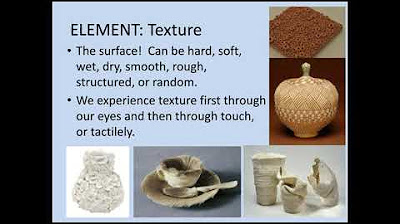Master the 7 Elements of Art (And Instantly Improve Your Paintings)
Summary
TLDRIn this video, the artist introduces viewers to the seven foundational elements of art: line, shape, form, color, value, texture, and scale. Through an abstract painting process, the artist demonstrates how to use these elements intentionally, with an emphasis on variety, contrast, and depth. The importance of color and value is highlighted, along with techniques like scumbling, layering, and texture manipulation. The artist also explores the creative process, using inspiration from nature and experimenting with different tools to create a dynamic, engaging piece. The video provides a deep dive into the practical application of art principles to elevate one's artwork.
Takeaways
- 😀 Understanding the seven foundational elements of art: line, shape, form, color, value, texture, and scale is essential for creating great artwork.
- 😀 Variety is key in art. Using different types of lines, shapes, and colors can make a piece more dynamic and sophisticated.
- 😀 Shape comes in different forms, both geometric and organic. Overlapping and varying shapes can create depth and interest in artwork.
- 😀 Form refers to the three-dimensionality of an object or shape, created through the use of value and light to give the illusion of depth.
- 😀 Color is a powerful element. It includes hue, saturation, and temperature, and can influence mood, depth, and overall impact in artwork.
- 😀 Value, which refers to how dark or light something is, is critical for creating contrast and depth. A balance of darks, midtones, and highlights adds realism.
- 😀 Texture can be both actual (tactile) and visual (illusory). Using different techniques such as impasto, dry brushing, or scraping can create interesting textures in your work.
- 😀 Scale plays a significant role in creating depth and visual interest. Using a variety of sizes and overlaps helps to create a sense of space in an artwork.
- 😀 The balance between light and dark values, as well as the appropriate use of color, is crucial to achieving a high-quality piece of art.
- 😀 Don't be afraid to experiment with new color combinations or techniques. Sometimes 'happy accidents' can lead to beautiful results, as shown by the unexpected pink ink flow.
Q & A
What are the seven foundational elements of art mentioned in the video?
-The seven foundational elements of art discussed in the video are line, shape, form, color, value, texture, and scale.
How can variety in line improve the quality of art?
-Variety in line, such as using different thicknesses, colors, and edges (fuzzy or sharp), helps make the artwork more dynamic and sophisticated. Consistency without variation can lead to boring or monotonous art.
What is the difference between shape and form in art?
-Shape is a two-dimensional object, while form refers to the three-dimensional quality of an object, adding depth and mass. For example, a flat shape can be given form by using value to create the illusion of depth.
Why is color considered a crucial element in art?
-Color is vital because it influences mood, depth, and visual interest. The video discusses how saturation, hue, and temperature of colors can significantly impact the visual outcome of a piece.
What is the role of value in art, and why is it so important?
-Value refers to how dark or light a color is. It is crucial because it helps create contrast and depth, allowing the artist to achieve a three-dimensional look. A good balance of darks, lights, and midtones is necessary for a strong piece of art.
How does texture impact abstract art?
-Texture can be either actual (physical texture created with thick paint or modeling paste) or visual (illusionary texture achieved through techniques like dry brushing). Texture adds interest and depth, especially in abstract works.
What is scale, and how does it contribute to the composition of art?
-Scale refers to the size relationships between elements within the artwork. Using varying sizes of shapes creates depth and visual interest, making some elements appear closer or further away, enhancing the sense of space.
How does the artist plan to use color in the abstract painting?
-The artist plans to use a color relationship involving violet, green, and gold. By varying saturation and creating contrasts between muted and intense colors, the artist aims to create a dynamic color story.
What is the significance of using both opaque and transparent layers in the painting process?
-Opaque layers are used to highlight areas and intensify color, while transparent layers allow for a more subtle buildup, creating depth and atmosphere. This layering technique enhances the richness and complexity of the painting.
What role do the 'happy accidents' play in the creative process?
-The 'happy accidents' occur when something unexpected happens during the painting process (like the ink drifting down) that leads to a positive result. The artist embraces these moments as part of the exploration and experimentation in abstract art.
Outlines

Cette section est réservée aux utilisateurs payants. Améliorez votre compte pour accéder à cette section.
Améliorer maintenantMindmap

Cette section est réservée aux utilisateurs payants. Améliorez votre compte pour accéder à cette section.
Améliorer maintenantKeywords

Cette section est réservée aux utilisateurs payants. Améliorez votre compte pour accéder à cette section.
Améliorer maintenantHighlights

Cette section est réservée aux utilisateurs payants. Améliorez votre compte pour accéder à cette section.
Améliorer maintenantTranscripts

Cette section est réservée aux utilisateurs payants. Améliorez votre compte pour accéder à cette section.
Améliorer maintenant5.0 / 5 (0 votes)






